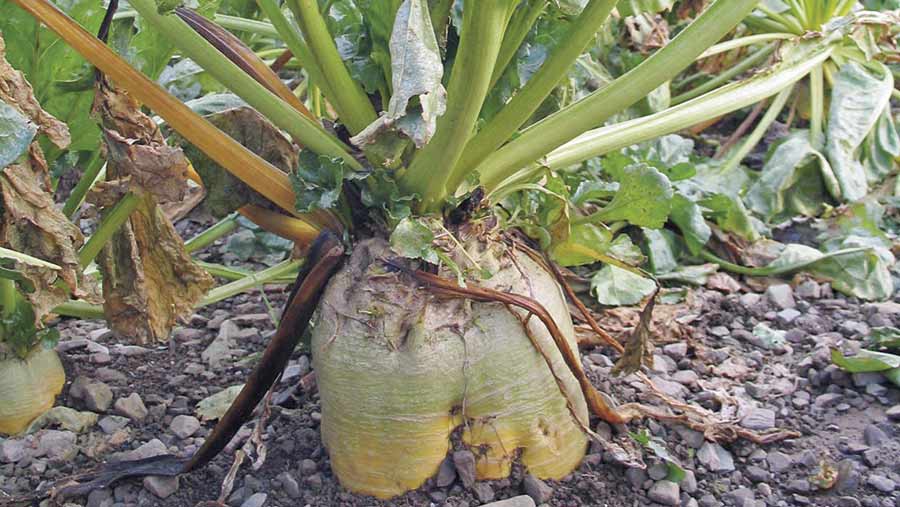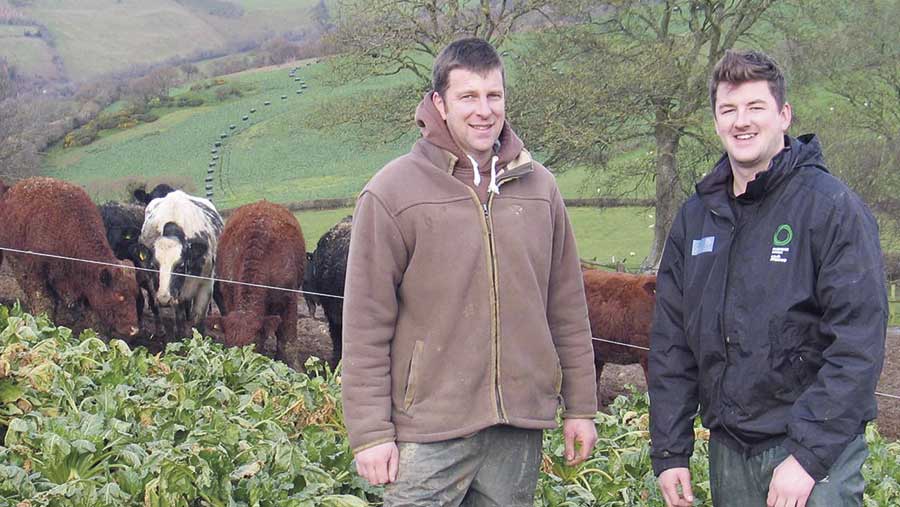The benefits of fodder beet and how to get the best from it

Growing fodder beet as a winter crop is allowing a Welsh upland farm to significantly reduce wintering costs.
Even at a conservative yield of 18t DM/ha, fodder beet can provide more than double the dry matter of kale, which averages 7.5t DM/ha.
But the crop needs good attention to detail at the establishment and growing stages to achieve this exceptional dry matter potential.
See also: What to do if feed is running low on your farm
Fodder beet’s high yield means less land is needed to grow the winter feed requirements of livestock and this was a big draw for Arthur and Menna Williams.

Fodder beet’s high yield was a draw for Arthur Williams (left), pictured with Emyr Owen of Farming Connect
Their farm, Carwed Fynydd, near Denbigh, has free draining soils and they have taken advantage of this by growing crops for winter grazing.
As a Farming Connect Focus Site they are growing fodder beet for the first time to compare its performance to housing and their traditional system of out-wintering on kale.
Three hectares have been planted for grazing 20 R2 breeding heifers for 150 days and also 500 in-lamb ewes for 70 days prior to housing.
To supplement the diet, baled silage will provide 50% of their daily dietary needs.
At £646/ha, the crop cost £1,939 to grow; in comparison, silage and straw at housing for the equivalent number of stock would have been in the region of £7,860, says Rhidian Jones, of Kite Consulting, who analysed the trials results on behalf of Farming Connect.
Based on these figures, that represents a three-to-one return on investment, he calculates.
“The annual cost benefit of fodder beet compared to housing is £5,921, or £1,974/ha,” says Mr Jones.
The cost of growing kale – £216.99/ha – is cheaper but the yield is less than half that of fodder beet.
‘High investment crop’
Grassland and forage specialist Charlie Morgan, who provided advice at Carwed Fynydd, says fodder beet is a good main crop for winter feeding but without attention to detail potential yield can be lost.
Yield is a significant reason why more farmers are introducing it into their rotation, he says.
“It is a high investment crop to grow but it can facilitate an increase in stocking density and release opportunity elsewhere.
“You need half the acreage to grow the equivalent dry matter of other brassicas and in areas where land is at a premium this is a huge advantage.”
He values a megajoule of energy for both fodder beet and kale at 1p, but fodder beet produces more feed on a smaller acreage and this means fewer inputs.
Also, because fodder beet is not a brassica, it provides another break in the rotation.
Although it can be grazed by both cattle and sheep, Mr Morgan believes it is better suited to cattle.
“Cattle eat their way through it more quickly so you haven’t got the issue of water pooling,” he says.
Runback is important. Mr Morgan advises sowing the crop in the centre of fields, leaving the boundaries as runback for livestock to lie on and for placing silage or straw bales as fibre in the diet.
Charlie Morgan’s 11 tips for getting the best from fodder beet
- Best suited to light and medium bodied, free draining soils to minimise run-off; it doesn’t perform well in wet and heavy soils.
- Test soils; all decisions need to be based on a soil test. A fodder beet crop will remove a tonne of lime/acre.
- pH must be 6.5 and the crop has a high potash requirement – 300kg/ha in a standard index of 2.
- Sodium levels are important – the crop is derived from sea beet; by adding 100kg/ha of salt to a seedbed yields can be significantly increased.
- It is advantageous to apply boron to the soil bed.
- Choose a field with multiple entry/exit points.
- Varieties range from 12% DM to more than 20%; the beets in low DM varieties stick out of the ground and are easier for livestock to eat. “You can have 60% of the beet above of the ground and with the tops as well that’s a lot of feed standing proud,” says Mr Morgan.
- Plant at a depth of 2-3cm, ideally in a field that has grown brassicas over the winter to provide a clean seedbed; seeds need to be planted in a ploughed field, not direct drilled.
- Soil temperature must be a minimum of 7C at planting and this dictates when it is sown; in some parts of the UK this can be as early as March but several weeks later in others.
- Introduce livestock to the crop gradually to prevent gorging.
- Close attention to agronomy is important. “Make sure you buy treated seed and are on the ball with spring planting,” says Mr Morgan. “The crop should be sprayed at least twice during the growing season, ideally three times. I have seen crops in which the tops have turned into a black mush where spraying has been overlooked.”
